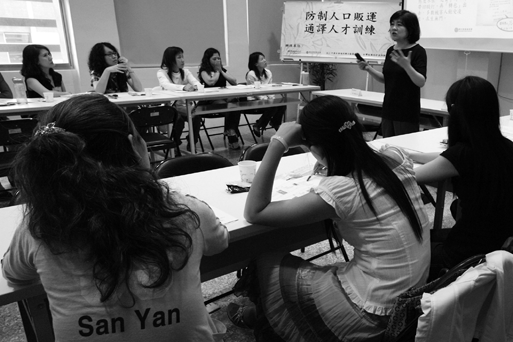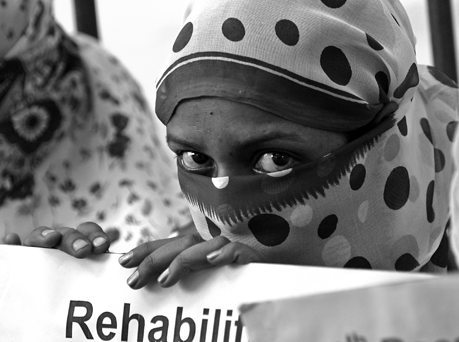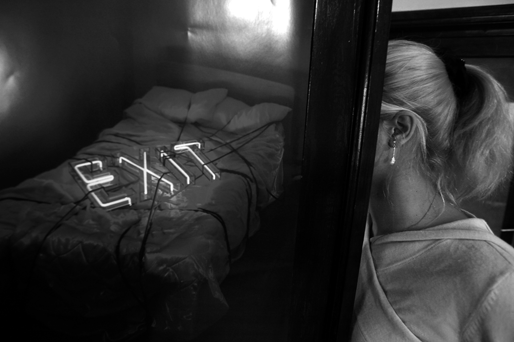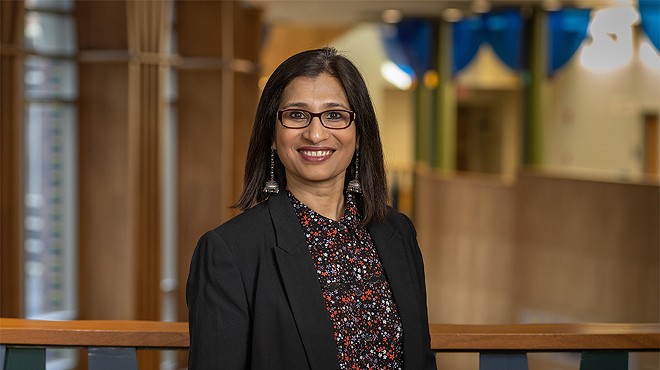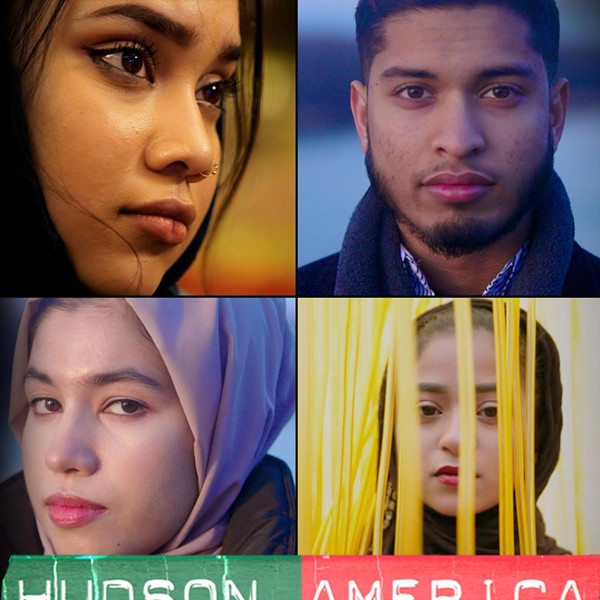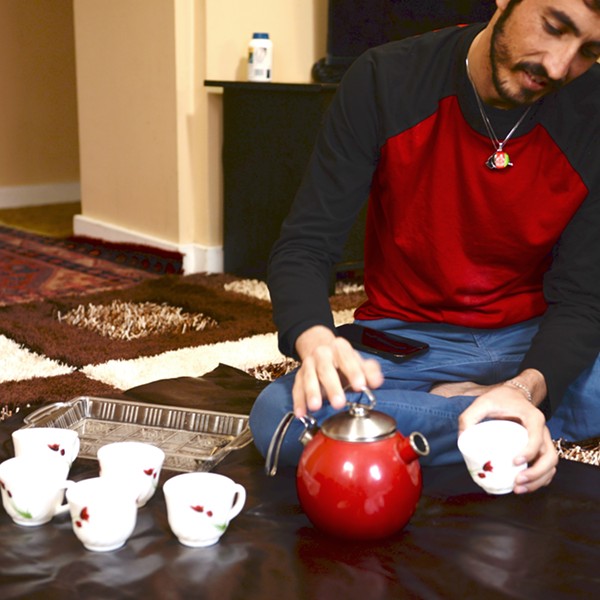In Alexandropoulos, Greece, a Nigerian woman spends her nights servicing men in the hopes of paying off the 40,000 euro debt that she owes the man who smuggled her there. Promised a better life working in a Greek bar, she has instead been forced into a life of sexual servitude. She cannot leave because the man has made sure she fears the native African voodoo spell that has bound her to repay the 40,000 euros.
In Seoul, a Filipina dances naked on a tabletop. Lured to Korea with the promise of marrying an American GI, her third day there finds her bound by her travel debt and unable to speak the language.
In Bombay, a premenstrual girl, bought in the rural Indian countryside, cries out as a silver-haired brothel patron, who has paid for her virginity, rapes her. If she starts to bleed, the madam of the brothel will give the girl ice before sending the next man in. This night, 25 men or more may rape her. If she resists, she will be beaten.
On May 13 of this year a wild-eyed Indonesian woman covered in bruises runs into a Dunkin Donuts dressed only in pants and a towel. Forced to work as an indentured servant for a wealthy couple in Muttontown, Long Island, her life is a hell of physical abuse involving sticks, knives, and cigarettes.
Trafficking of human beings—the domestic or global transfer of people for cash, through deceit, exploitation, or force—is one of the most lucrative forms of international illegal trade, second only to drug smuggling. According to the US State Department’s Trafficking in Persons Report, approximately “600,000 to 800,000 people—mostly women and children—are trafficked across national borders” each year. This does not include the millions trafficked within their own countries. Human trafficking—a contemporary form of slavery—is a global industry with sticky, money-hungry tendrils that extend to every nook and cranny of the world.
According to Wenchi Yu Perkins, director of the New York office of Vital Voices Global Partnership, an international nonprofit organization that has worked closely with issues surrounding the trafficking of women, the term “human trafficking” was coined in the late '80s to early '90s as both a tool and a weapon by nongovernmental organizations (NGOs) to address a brutal industry that was beginning to attract more attention. The term “trafficking in women,” however, has been around since 1910, when prostitutes known as “white slaves” were trafficked for sexual exploitation.
While trafficking has been happening for thousands of years, thinking of it in terms of the sexual exploitation of women is a modern phenomenon. Perkins believes this is due to two factors: that the media finds the subject of women being sold into sexual bondage “sexier” and induces more sympathy than labor exploitation, and the fact that the anti-trafficking movement originated from the women’s rights struggle.
Moisés Naím, editor-in-chief of Foreign Policy magazine, claims that the
$7 billion migrant smuggling industry, which includes the smaller human trafficking industry, is one of the “five wars of globalization,” along with the drug, illegal arms, money laundering, and counterfeit goods industries.
Trafficking vs. smuggling
“Smuggling and trafficking are two very different things,” said Perkins. “You could be a smuggled person in the beginning, but then end up being trafficked. It’s all about whether you are exploited or not. A smuggled person is a criminal and should be [considered] a criminal. But if you are taken advantage of in the process [of being smuggled] you are exploited. If you are forced or if you are deceived in some way then you become a trafficked person. Then, you are a victim.”
“Here we are in the 21st century and we’re talking about slavery,” said Ambassador-at-Large on International Slavery John Miller upon release of the State Department’s sixth annual Trafficking in Persons Report in June 2006. “Wouldn’t this be a shock to our abolitionist ancestors who thought they finished the job back in the 19th century?” More recently in an op-ed for the Los Angeles Times, Miller commented further, “The international slave trade reaches into every country around the world and involves, at the least, a few million people and, by some estimates, as many as 27 million. It includes exploitation and ‘bonded’ labor—in which people are held against their will and forced to work on farms or in factories to pay off obligations that never end.”
Painted smiles
In Chiba, Japan, provincial Filipina and Malaysian girls in short shorts and skirts, cheap sleeveless shirts, and painted smiles circulate around a large room taking a moment to refill drinks and exchange flirty words with the foreign and Japanese customers. Emboldened by alcohol, the customers grow louder and their banter shifts to that of a more sexual variety.
The scene is that of a typical hostess bar, a style of establishment that dots Japan’s cityscape and countryside. There, overworked businessmen pay to be in the company of women, foreign and Japanese alike, who pour their drinks and engage them in conversation. The only difference is that this hostess club is impersonating a Filipino restaurant, complete with menu posted out front, but the smiling girls inside are not serving food. They are serving sexual satisfaction. These girls have been trafficked.
“They were obviously being exploited and they were all really unhappy,” Maria Panana, a Tagalog-English translator for a US State Department Human Trafficking project, told me during an interview. She had visited the club a number of times, under the guise of a secretary for a foreign customer, and had attempted to extract the stories from the women sitting with her and her “boss.”
Although many of the girls were wary, Pacana did manage to coax one hostess into divulging the club’s secrets. The girl, somewhere between the ages of 18 and 24 years old, had been in Japan for three months. Like the others, she wore cheap, revealing clothing and was heavily made up. In the Philippines, a “recruiting” company had hired her for a song and dance troupe that was to perform in Japan. Young, poor, and naïve, she embraced the opportunity and set out for Japan on a temporary six-month entertainer’s visa. When she arrived she found a life far different than she had imagined.
The girl had been living in a tiny, Japanese-style dorm directly above the bar along with a number of other girls. Those who did not live in that room lived one train station away. Their movement was limited to the dorms and the club, unless they had surpassed the three-month grace period, in which case they were forced to go on dohan.
“Dohan is basically when you go with a customer, off to a restaurant or something like that, then he takes you to a hotel and you sleep with him,” explained Pacana. The practice varies from establishment to establishment, with some bars encouraging their employees to dine with customers and keep them interested—but never submit to sexual pressures. Others, like the bar in Chiba, force the girls full-on into sexual relations. In all cases, going on dohan means more money for the bar and, quite often, the girl.
In the case of the bar in Chiba, however, Pacana sees it as a psychological trick. For the first three months, the girls act like typical hostesses, their sole responsibility to smile and pour drinks. Month four is when the dirty work begins. The catch to the whole situation is that the girls are not paid until the six months are up. If they leave after three months, they will leave as poor as when they came. Most girls, according to Pacana, see it in their best interest to grit their teeth, do as the customer says, and get it over with. Get it over with on a continual basis until their visas expire and they return home.
The girls, on the whole, are incredibly wary of immigration and of being deported back to the Philippines. Besides having to sleep with the customers, they also have to follow a drill set in place to hide from immigration. Whenever immigration officials enter the bar, the owner of the bar yells, “Line Dance!”—the cue for the girls to get up and leave the room. If the girls are caught, they are thrown in jail and deported in the typical law-enforcement approach to human trafficking. This punitive approach paints those trafficked as criminals, not victims, who upon arriving home face possible dangers, including violence from traffickers and pressures to pay the debt they may have incurred during the trip—not to mention the stigma of returning home empty handed.
Although this is a tale in a faraway land, it is a tale that is being repeated in various forms around the globe. The industry is not limited to the sexual exploitation of women, it also encompasses the sexual exploitation of children and the labor exploitation of men, women, and children alike. The tale is one that is unfolding in our backyards.
A global industry
According to Andrea Bertone of Humantrafficking.org, a web-based human trafficking watchdog organization, due to the underground nature of this modern-day slave trade, truly accurate numbers of the mass of people trafficked and exploited annually are elusive, as are which countries have the worst human trafficking records.
“One thing that everyone agrees on is to take a victim-centered approach, meaning that, really, you should take the victim’s spin, and think from the victim’s perspective,” said Perkins of Vital Voices. This shift in perspective, combined with an increasing number of voices in the international nonprofit sector, is beginning to push the media and academics into giving a more in-depth look at the human trafficking industry.
Each country has specific issues that it must tackle and each country must tackle their issues differently. According to Humantrafficking.org’s Bertone, overall it can be said that countries with large migrant populations typically have the largest reports of abuse. Internationally, the US is the most progressive country in the fight against human trafficking, with the Bush administration, in particular, being the most aggressive. Although former president Bill Clinton signed the Trafficking Victims Protection Act of 2000 directly prior to his leaving office, incoming president George Bush was left to implement the act—a task he took on with great vigor.
The Trafficking Victims Protection Act led directly to the publication of the Trafficking in Persons Report, which addresses “severe forms of trafficking in persons” defined as: “(a) sex trafficking in which a commercial sex act is induced by force, fraud, or coercion, or in which the person induced to perform such an act has not attained 18 years of age; or (b) the recruitment, harboring, transportation, provision, or obtaining of a person for labor or services, through the use of force, fraud, or coercion for the purpose of subjection to involuntary servitude, peonage, debt bondage, or slavery.”
The US Trafficking in Persons Report places the countries in one of three tiers and one “watch list” subtier. Tier 1 is reserved for the countries whose governments fully comply with the minimum standards for the elimination of trafficking. Countries whose governments do not fully comply, but are making significant efforts are placed in Tier 2. Countries who fall under Tier 2 and have a very significant or increasing number of victims, fail to show increasing efforts to combat trafficking from the previous year, or have been assessed as making significant efforts to comply based on commitments to take steps over the next year are placed in the Tier 2 watch list. Countries that do not meet with the minimum standards and are not making significant efforts to do so are placed in Tier 3.
“Shaming and blaming”—a technique used by NGOs and governments alike, especially in cases where no legal recourse is available—has been used to point fingers at nonconforming countries by bringing intense media attention to issues within those countries that may not be on par with international standards. This negative spotlight “shames” the non-conforming country into adjusting its laws in order to reach the international standards or to avoid sanctions. With this report, the game of shaming and blaming begins and those governments who are affected by this technique will endeavor to be in Tier 1.
Western Europe, where almost all the countries fall into Tier 1, is next in line in terms of progressive action toward the trafficking of human beings. However, the focus on these countries is more on sexual than labor exploitations, according to Bertone. Western European countries not included in Tier 1 are Greece, where Albanian Roma children are trafficked and are forced to beg and steal; Malta, which is a destination country for sexual exploitation; and Portugal, where the exploitation of women from its former colony of Brazil is rampant. These countries are all listed in Tier 2, while some, such as Monaco and Liechtenstein, are not listed at all because of a lack of data.
Asia is next in terms of its progressive stance. This is due to interest generated in the 1980s to rampant child-sex tourism. All Asian countries, save South and North Korea (Tier 1 and Tier 3, respectively), fall into the Tier 2 category. Africa, with its internal conflicts and under-funded NGOs, lags behind, according to Bertone, as does South America, which is just now starting to develop NGOs. Data has been lacking on migration linkages between the West and South America. However, both Africa and South America have many of their countries falling into the Tier 2 category. As for the Middle East, where gender inequality is pronounced, most of the countries fall into the Tier 2 and the Tier 2 Watch List. Saudi Arabia, Iran, Uzbekistan, and Syria, however, have all been listed in Tier 3.
Due to “extenuating circumstances in transitioning states, and information that is incomplete, unclear, contradictory or difficult to corroborate,” Iraq, along with eight other prominent nations, which include Liberia, Somalia, Haiti, Brunei, The Bahamas, Lesotho, Swaziland, and Turkmenistan have not been included at all. However, each of these nations “merit special mention because there are indications of trafficking in each of these countries.”
Stopping the Traffic
Interestingly, the US is not mentioned in any of the tiers. Perkins attributed this to the State Department’s purpose of highlighting what is happening in other countries, while another department, the US Department of Justice, puts out an annual report to assess internal issues.
“The US tends to be much more out there in terms of going to other countries and saying, ‘This is what you should do,’ whereas other countries don’t take that approach,” explained Perkins. Other countries and organizations that have shown great interest in human trafficking include Sweden, the United Kingdom, most of the Western European countries, The Organization for Security and Co-operation in Europe (primarily composed of European states, but also includes countries from Central Asia and North America), and the UN Inter-Agency Project on Human Trafficking in the Greater Mekong Sub-region (UNIAP), which includes Cambodia, China, Lao PDR, Myanmar, Thailand, and Vietnam and brings together 13 UN agencies and eight international NGOs.
The UNIAP, said Perkins, is “kind of a pioneer project for the UN. There is no other region with this kind of initiative. It’s purely for high-level governmental officials who get together several times a year to really mobilize their governmental forces on this issue.”
Sweden, for example, is targeting brothel owners, traffickers, pimps, and customers instead of targeting prostitutes. The result? People are scared of prosecution and since this program was enacted, numbers regarding known trafficking in Sweden is down.
Who are the trafficked?
“Anybody can be trafficked,” regardless of gender or age, said Gabriela Villareal, an anti-trafficking program coordinator for Safe Horizon, a New York-based NGO that aids trafficking survivors. The desire for economic upward mobility and the promise of greater earning power in a more economically prosperous location are typical traits of those trafficked.
The Filipinas trafficked to Japan are a good example. Poor young girls from the countryside who see the money earned in Japan as a way to better their quality of life, they were easy prey for traffickers. “Here in New York, the majority of the victims that I have seen come through Safe Horizon, have been from Central America, South America, and the Caribbean,” said Villareal, which are all poorer countries.
Villareal further testifies that 51 percent of the victims aided by Safe Horizon have been victims of labor exploitation. This statistic has stayed consistently above the 50 percent mark. “There have been a really wide variety of cases identified with human trafficking exploitation in the area,” claimed Villareal. “For example, there is the case of indentured servitude and debt bondage out in Long Island; there was a family trafficking ring that operated between Mexico and the US for the exploitation of women for commercial sex. [There’s also a] UN diplomat who was forcing somebody into indentured servitude. It’s quite a wide range.”
Perkins credits the US government’s shift in focus to Ambassador Miller, who over his course as ambassador-at-large, came to see human trafficking for labor exploitation as a much bigger issue. The focus on trafficking has grown tremendously since 2002.
Who are the traffickers?
“Like the victims, the traffickers can be anybody,” said Villareal. “Traffickers can be those least expected such as diplomats who work for the UN or international organizations, intimate partners, employment agencies, as well as family members, or friends and acquaintances.” Specifically, in relation to indentured servitude, the traffickers “can also come in the form of highly educated professionals that are contributing members of society that you wouldn’t necessarily assume to be violating someone’s human rights.”
In January 2001, the Washington Post reported on a Zambian UN official charged with paying a man, also from Zambia, $160 dollars a month to clean his 11-room Westchester home and care for his autistic son. When asked for a raise and permission to work a part-time job, the official told the man that immigration officials would deport him. According to the Post story, the diplomat’s co-workers showed genuine surprise over the allegations and said that he was a “perfect gentleman.”
That case followed hot on the trail of another case reported in the New York Times in April 2000. An indentured servant from Bangladesh, brought to the US to work in the high rise apartment of a high-ranking UN diplomat from Bahrain in New York City, was forced to work seven days a week on meager wages. The money she did earn was sent directly back to her husband in Bangladesh. Unable to speak English, she finally escaped with the help of a friendly street vendor who spoke Bengali.
“There is also an element of informal criminal networks [involved in trafficking and] that are transitional in nature,” explained Villareal. These networks include such standard hierarchy networks as organized crime, and core groups, which are multi-ethnic with a strong core membership and an ever-transitioning periphery.
Supply and demand
Human trafficking is one of the most brutal versions of the mercantile system of supply and demand. The victims, known as the supply, are drawn into the industry via economic means—the idea of a better life elsewhere, to escape poverty—and also via more dire means—violence, organized crime, governmental corruption, local instability, armed conflict, and kidnapping. Children are drawn in because families, in desperate need of cash, sell the children, or because the families are led to believe that their child will be well taken care of, receive an education, and/or send home remittances. This is often not what happens.
In an interview conducted by the TV show “Adventure Divas” with Ruchira Gupta, founder of Apne Aap, a nonprofit organization in India which works with women and children trafficked domestically and forced to work in the country’s brothels, Gupta gave a typical account. “In a village, a couple has a small child, and she’s a daughter. They are in desperate need of money. They might mortgage the child to the local agent—everybody knows who the trafficker is in the village—and they might say, ‘Give 3,000 rupees now, and when she’s seven or eight or nine, we’ll give the girl to you.’ So they would borrow against their daughter, then when she was seven or eight or nine, the trafficker would say, ‘Okay, now it’s time for me to take the daughter.’”
Economic need—parents so desperate, they sell their children to an uncertain life and, in the case of sexual exploitation, most likely a life of AIDS and violence. The demand side, facilitated by technology, involves a growing sex industry and an increasing demand for exploitable labor.
The stages of trafficking
The act of human trafficking happens in three stages: recruitment in the origin country, transportation and potential illegal entry of the trafficked person in the transit country, and exploitation in the destination country.
Stage one starts with the traffickers approaching the victims either through “recruitment” practices or through more extreme means, such as kidnapping. Often, women and children are sold by family members lured by deceptive ads placed by employment and travel agency employees—the actual traffickers. Often unaware of the danger they are putting their loved ones in, family members cling to promises of receiving high profits through remittances. The deceptive nature of recruitment also pulls in grown adults, who may know the nature of their work, whether it is sex or labor, but are unaware of the level of exploitation they will suffer.
Stage two is not only confined to the point in time when a trafficking victim crosses a national border, but is considered to be part of the whole process. Common tactics include taking the victim’s passport, confining, coercing, or forcing the victim to be part of a forged document scam, manipulation of immigration and border-control, and deals made with corrupt governmental officials.
In stage three, the victims, as they are now accurately called, often find themselves facing language barriers, illegal residency status, forced work against their will with very little pay, a huge debt “incurred” while traveling, and violence. The victims are completely dependent on the legal system in a country where they are fearful to speak out for risk of deportation. The traffickers and new “owners,” who have paid for the victims, play on this fear.
Take action!
At the Trafficking in Persons Report briefing in 2006, Ambassador Miller told those gathered that both from the US State Department’s prerogative and from his own travels around the world, it is apparent that “more and more shelters are opening up to care for trafficking victims.” Along with more shelters, said Miller, there has also been a rise in traffickers convicted worldwide—from only hundreds several years ago, to roughly 3,000 convictions in 2005, and 4,700 in 2006. This, according to Miller, is sending the message that trafficking will be fought and traffickers will be prosecuted.
In order to encourage this message, Polaris Project, a Japan- and US-based NGO with a mission to combat human trafficking, has published a list on its website of “Eleven Ways to Fight Modern-Day Slavery.” Based on the premise that anybody can become involved in combating the horrors of trafficking, steps one and two encourage self-education and educating others on the topic.
Another anti-trafficking NGO, Humantrafficking.org, provides a toolkit for identifying signs of trafficking, and what do if someone is suspected of being a victim of trafficking. Once armed with this information, anyone can report a suspected trafficking case by calling the Human Trafficking Information and Referral Hotline, getting in contact with the state attorney general victim coordinator, contacting the FBI, or contacting an NGO, such as Safe Horizon, that directly helps victims of trafficking.
There are roughly 12 million undocumented illegal immigrants in the US. If the most recent immigration bill put before the Congress were to pass, proponents cite that border security will be strengthened, a guest-worker program will be established, and those 12 million undocumented illegal immigrants will have the ability to stay in the country regardless of their mode of entry or activities since entering and possibly become citizens. However, of those 12 million it is not known just how many are actually victims of trafficking. According to US State Department figures, between an estimated 14,000 and 17,500 people are trafficked into the US annually.
With much of the controversy surrounding the bill focused on illegal Mexican laborers, there has not been mention as to what will happen to the trafficked victims who have come from all corners of the world. Nor has there been mention as to what mechanisms the US government will implement if the bill is passed that will ensure victims do not disappear into the woodwork and not become victims twice over—first, from the trap of the modern day slave industry and second, from an immigration bill that has not adequately assessed their predicament, nor has made any attempt to put an end to these violations of international law.
For more resources on human trafficking and the anti-trafficking movement:Vital Voices; Safe Horizon; Adventure Divas; Apne Aap, Ruchira Gupta;US Department of State: Human Trafficking and Human Smuggling;UN Human Trafficking in Human Beings:
Adair K. Fincher was born in Woodward, Oklahoma, but raised in the international setting of Tokyo, Japan. Fincher is now pursuing her MS in Global Affairs at New York University.
